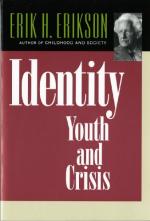
|
| Name: _________________________ | Period: ___________________ |
This test consists of 15 multiple choice questions and 5 short answer questions.
Multiple Choice Questions
1. What does Erikson state that childhood and youth predispose men to?
(a) Confused identities.
(b) Childlike wonder.
(c) Structure.
(d) Totalitarianism.
2. What did Shaw convinced himself he was?
(a) A complete outsider.
(b) A helper.
(c) A leader.
(d) A genius.
3. How the James decide he could strengthen his ego?
(a) Meditating and breathing.
(b) By doing, suffering, and creating.
(c) Embracing positive experiences.
(d) Simply learning.
4. Because the terms "identity" and "identity crisis" are used in such a variety of situations, what have these terms become?
(a) Embedded in society.
(b) Well-defined.
(c) Coined.
(d) Ritualized.
5. In discussing Freud's views on group identity, what does Erikson state is a major cause in identity becoming frustrating and disintegrated?
(a) When there are too many leaders.
(b) When the group disbands.
(c) When groups members do not have their own identity.
(d) When the role of identity in a group changes.
6. What might gaining a stronger self identity correspond to in relation to the majority of the population?
(a) Totalitarianism.
(b) A strong societal bond.
(c) Anarchy.
(d) Emancipation from society.
7. According to Freud, what is the first stage of identity development called?
(a) Oral stage.
(b) Phallic stage.
(c) Anal stage.
(d) Latent stage.
8. What may be gained as an individual enters Erikson's final stage of development when their overall development has been positive and healthy?
(a) Reflection.
(b) Peace.
(c) Wisdom.
(d) Hopelessness.
9. According to Erikson, what does totalitarianism require of society?
(a) Conformity.
(b) A combination of identities.
(c) Nothing.
(d) A sense of legitimacy of state power.
10. What does Erikson feel may have been lost to modernity?
(a) Ideologies.
(b) Self-identity.
(c) Self-preservation.
(d) Cosmic wholeness.
11. What is one example that Erikson provides for the notion of "evil ego identity"?
(a) Self loathing.
(b) Confusion.
(c) Gender stereotypes.
(d) Ethnic stereotypes.
12. As noted in Chapter 2, how can false or inaccurate ego identity formations be corrected after being developed by parents in terms of group identity development?
(a) Through psychotherapy.
(b) By immersion.
(c) By reworking associations.
(d) They cannot be corrected.
13. According to Erikson in Chapter 2, what occurs when the ego combines elements that result in an inability to form a positive self-image?
(a) No identity formation.
(b) Stereotyping.
(c) Ego synthesis fails.
(d) Negative identity formation.
14. In Chapter 2, what does Erikson feel about how psychologists treat social dynamics and external social elements?
(a) As deep rooted elements of social identity.
(b) As keys to social competence.
(c) The coexist.
(d) As surface events.
15. What does Erikson's theory suggest concerning how children gain a sense of what their adult identities should be?
(a) Learning about being an adult.
(b) It comes natural.
(c) By looking to community members.
(d) Watching TV.
Short Answer Questions
1. What does George Bernard Shaw despise?
2. During the final stages of Erikson's stages of identity development, what type of feelings may individual experiencing stagnation feel?
3. As discussed in Chapter 1, what first lead to the scientific mythology of the mind?
4. What was Shaw exposed to as a child?
5. Erikson notes that James' youth was full of emotional strains in struggles for what?
|
This section contains 499 words (approx. 2 pages at 300 words per page) |

|




